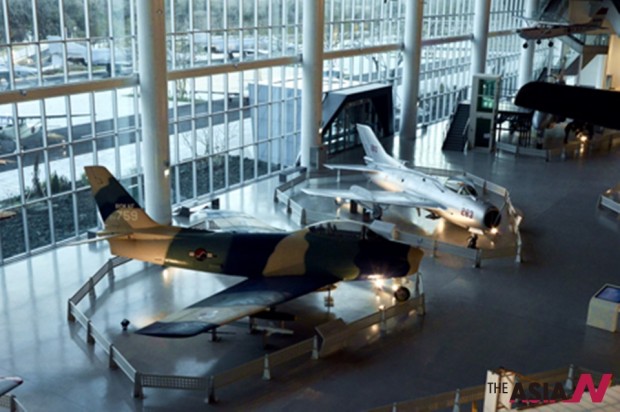Asia’s largest aerospace museum to open in Jeju on April 24

Retired planes donated by the Korean Air Force are exhibited on the first floor of the Jeju Aerospace Museum. (Photo : Korea Times)
JEJU — Aerospace museums are typically places with cool airplanes that visitors must not touch. The new Jeju Aerospace Museum (JAM), however, will let you sit in the cockpits.
The 30,000-square meter institution, which will open on April 24 on the island’s Seogwipo City, is claimed to be the largest aerospace museum in Asia.
Located next to the Osulloc Tea Museum, JAM is designed to resemble an angled spaceship from the outside. Inside, visitors can find thousands of items that are representative of the history in aerospace technology and space science.
The highlight of the collection includes fighter jets used during the Korean War (1950-53), a replica of the Wright brothers’ Flyer 1 model built in 1903, and dozens of retired planes donated by the Korean Air Force that hang from the ceiling of the museums’ massive main hall.
Visitors can sit in the cockpit of five aircrafts — the twin-engine Cessna T-37 Tweet, from the 1950s, the piston-engine Cessna T-41B Mescalero (1960s), the American military transport aircrafts Fairchild C-123 Provider (1950s) and Douglas C-54 Skymaster (1970s), and the Bell UH-1 Iroquois helicopter (1950s).
JAM was a result of a 115 billion won (about $108 million) investment by the Jeju Free International City Development Center (JDC).
The four-story building consists of exhibition halls on the first and second floors. The third floor is a commercial zone with food courts and other facilities and the fourth floor is an observatory.
“Many people have flown on planes before but this is your chance to sit in a real cockpit,” said Oh Hyung-jin, one of the museum’s public relations officials, during a tour for journalists last week.
“The aircrafts you can climb into are real ones that served important functions when they operated, so the experience will feel special. The three larger aircrafts needed to be displayed in the space outside the building and we have made photo booths for two of the planes displayed inside (Cessna T-37 Tweet, Cessna T-41B Mescalero) for visitors looking for a nice picture angle.”
At the entrance of the museum, visitors will first see “Gibeon,” one of 274 meteorites donated to the museum by Kim Dong-seob, head of the Korea Meteorite and Mineral Research Center, which they will be allowed to touch.
Then visitors will walk into the majestic scene of dozens of planes suspended from the 40-meter-high ceiling. Some of the larger aircraft donated by the air force, including retired fighter jets, are exhibited on the ground.
The museum displays 34 retired planes, but its replicas are also notable, especially the Wright Flyer 1.
The first floor is devoted to the history of manned flight. The descriptions on the evolution of designs and plane engines are juxtaposed with the actual machinery. There is a special exhibition dedicated to the Korean Air Force and also a section where visitors can control a virtual plane through flight simulators.
At the far end corner of the first floor, is an exhibition called “How Things Fly,” which features items provided by the Smithsonian Museum in Washington D.C. JAM signed an agreement with Smithsonian to offer the exhibition translated into Korean. This exhibition is geared toward children and young students.
The second floor is the Astronomy and Space zone, which offers exhibitions of how the universe was created.
After crossing the Space Walkway, which is meant to be an experience similar to walking on a spaceship, there’s a mystic electric ball which thunders with the big bang sound and starts explaining the birth of the universe when you put your hands upon it.
“We’re also planning to allow visitors to try on spacesuits like the one that’s exhibited here,” said Oh.
The second floor also offers a variety of entertainment options.
The domed “Canopus” is a planetarium where visitors can sit back in their moving seats to watch a selection of 30-minute education programs.
The “Polaris” is a circular, high-tech theater where the wall doubles as a 360-degree screen. The theater promises a “virtual journey” into space with the help of stereoscopic content and sound effects, although visitors will have to wear those clunky three-dimensional (3D) glasses.
“Procyon” is a room where visitors can create digital “avatars” of themselves and beam them to an interactive wall.
A separate experimental facility is “Orion,” which allows visitors to have fun with 3D motion-based simulators that track their movement.
Adults can buy an all-day pass for these services which include two or more visits to the themed zone for 23,500 won per person, although they will have to pay 4,000 won separately to use Orion. Regular tickets are 15,500 won. For children, the tickets cost 17,000 won for an all-day pass including entrance to the themed zones.
“We have a lot of experience-based exhibits at the museum. The trend these days is to experience rather than just to look,” said Oh.
“It will take about half a day to thoroughly check out the museum and participate in the programs. If you want to experience all of the themed zones, it could take you two days.”
The museum’s entire exhibition is offered in Korean and English. Digital material can also be screened in English upon request. For Chinese tourists, the museum plans to publish a separate guide book in Chinese. By Yun Suh-young, The Korea Times
























































